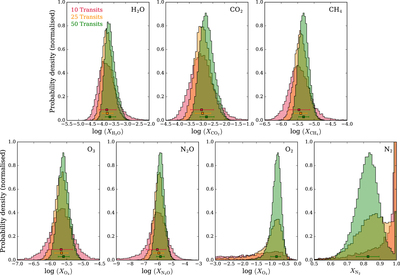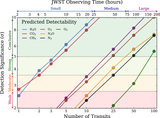Image Details

Caption: Figure 4.
Predicted atmospheric composition constraints for an Earth-like planet orbiting WD 1856+534 with JWST. Marginalized posterior probability distributions for the abundances of each detectable molecule are shown, considering 10-transit (red), 25-transit (orange), and 50-transit (green) programs. The error bars give the median retrieved abundances and ±1σ constraints. H2O, CO2, CH4, O3, and N2O can be constrained to <1 dex (an order of magnitude) with 10 transits, <0.4 dex with 25 transits, and <0.3 dex (a factor of 2) within 50 transits. Placing a lower bound on the O2 abundance is not possible for the 10- and 25-transit cases, hence the preferred solution is an N2-dominated atmosphere (﹩{X}_{{{\rm{N}}}_{2}}\to 100﹩%). Bounded constraints on the O2 and N2 abundances require at least 50 transits, after which they can be measured with an uncertainty of ≲7%.
Copyright and Terms & Conditions
© 2020. The American Astronomical Society. All rights reserved.






